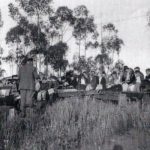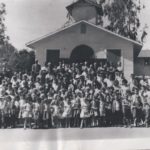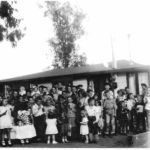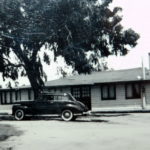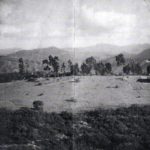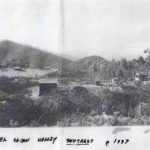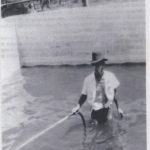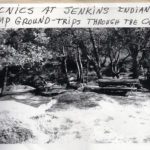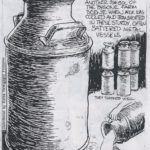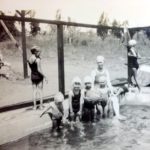Growth on “The Crest”
By the 1930s, Suncrest and La Cresta were two thriving, distinct communities, each with its own water supply, clubhouse, and store. Soon more and more folk found that permanent residency in this area was very desirable. More amenities soon appeared on “the hill.”
In 1933, the communities had more than 200 homes, telephones, rural mail delivery, electricity, and a school bus accommodating 31 school children. The La Cresta Club and the Suncrest Club were both working hard to improve their communities.
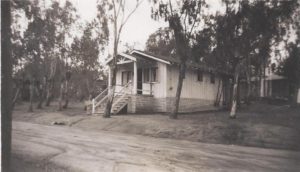
1933 – The First Church in Crest
The Crest Community Church began as a Sunday school in the home of Miss Lulu Satterlund on October 22, 1933. When attendance grew too large for her home, the Sunday school was then held in the Suncrest Clubhouse until 1935 when the building on the corner of Lento Lane and Madera Verde Pl was purchased and dedicated on November 3, 1935. It was written that Virginia Price’s dad turned the “ugly duckling” little house into a place of worship around 1940. This original building remains today on the corner of Madera Verde and Lento Lane. Between 1935 and 1941 three pastors were supplied by the Christian Missionary Alliance Church of EI Cajon. As attendance grew, the first preaching couple, Earl and Anna Majors, were called to the church in 1941. They resided in the house which was known as “the Mosque,” which was located on Eucalyptus Drive.
Sunday school was conducted weekly with an occasional preaching service until 1941. Between 1941 and 1948, five additional pastors served the church until Rev. Dallas Miller was called in 1948 and served until August 1951. During Rev. Miller’s ministry, a new church was built in front of the little existing church on Madera Verde and Lento and completed in 1952. The original church was then used for Sunday school
Library Services Come to Crest – 1935
Resident’s of Crest petitioned the County of San Diego in May 1935 for a library. A limited-service library opened June 13, 1935, closed June 29, 1937 and reopened in September 1939. Most of the time the library was in the home of someone willing to serve as librarian, and it was open only a few hours a week. For some time it was in the home of Mrs. Margeurite Steen who opened a portion of her living room on Loma Vista Lane as a small library. The hours for residents were between 3 p.m. and 5 p.m. and from 7 p.m. to 8 p.m. .The library closed again in March 1945.
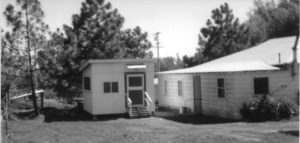
Water – A Critical Factor
As the population grew, it stressed the water system which consisted of wells. Both communities had a similar challenge to deal with – a shortage of water. During the depression years, more and more people moved into their places as permanent homes. In 1929, all water stand pipes were taken out and water was to be piped directly to the cabins at a one-time flat rate charge of $25. It was emphasized that only owners of the cabins were allowed to use the water.
Then came the problem of owners using more than their share of water. As a result, there were many weekends when there was just not enough water to go around. The original well was then deepened and gave relief for a short time, after which a second well was dug to give added relief.
Each community had wells that supplied their homes with water. La Cresta residents had their own water supply obtained from a well in Kalamity Canyon down La Cresta grade, not far from the top of the hill. The La Cresta Mutual Water Company was formed by B.A. Cornelius, Martin Ettel, O.V. Jarrett, John Livingston, and Joseph Robbins. The 1936 fee for a water connection with the Suncrest, Inc. water system was $1.50- payable at time of filing application. Nancy Cornelius Glasscock writes, “My father, Barney, was the one who dug the three wells and a cave to furnish La Cresta with water. He also engineered the big water tank on Highline Trail. He pumped the water to this tank and if he caught you wasting water or washing a car, he gave you a tongue lashing, two strikes and you are out! The third time he shut your water off and you would have to make a solemn promise not to repeat the offense.”
The Crest has its First Law Enforcement Officer
Jim Coats was appointed the first deputy sheriff in 1933. Mr. Dickinson (Kay Dickinson’s husband) was appointed deputy resident sheriff for Crest and served 9 years.
Suncrest’s First Boy Scout Troop #68
The troop received their charter on April 30, 1934. Scout Master was Glen T. Miller and his assistant Scout Master was Harold Clapper.
Suncrest Chamber of Commerce
The Suncrest Chamber was formed and was very active in community activities from 1937 to 1940. Glenn T. Miller was the first president. In July 1938, the Suncrest Chamber of Commerce and Suncrest, Inc., rival organizations, joined together and pledged to work in harmony for the good of the community.
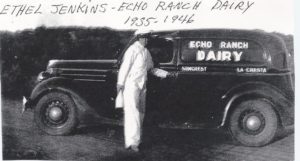
The Echo Ranch Dairy & the Jenkins Pool
In 1935, Ethel
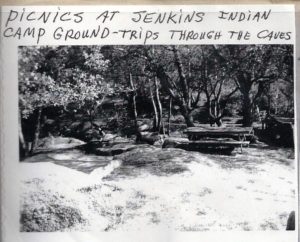
Jenkins decided to start a dairy which she ran for more than a dozen years. Beverly Nerbonne, Ethel’s daughter explained, “On the Echo Ranch Dairy we had Jersey and Guernsey cows which gave real rich milk, the cream coming halfway down the bottle. We started with only seven cows building to twelve. There were no milking machines, so they had to be milked by hand. Ethel Jenkins ran the dairy serving customers ‘on the hill’ as the Crest was known. The first milk was delivered in a 1931 Studebaker with the back end cut out to make it a truck of sorts. This was later replaced by a 1936 Ford panel wagon, which I learned to drive when I was 15. At first my brother Bill and a neighbor, Birk Merrifield, helped my mother milk the cows. Later, my brother Lewie helped. During the war years both brothers went into the service so the job of milking fell to me. Getting up at 3:45 a.m. did not appeal to me. I would work until I had to go to school, knowing those cows would be waiting for me when I got home. Since we didn’t raise our own feed, the dairy became a losing proposition, so mom decided to shut it down. This was in 1946 and the war was over. I can’t say I was unhappy about her decision. Many people were disappointed when we closed the dairy as their babies and growing children had done so well on the milk. I look back now and marvel at the strength and character of Mom during that work-filled decade.”
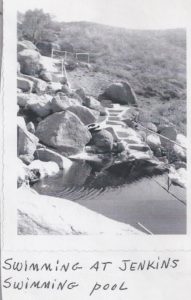
The Jenkins pool also brings back memories. The Jenkins swimming pool will bring back memories to many people. William Jenkins hired cement contractors in the 1930s to do the work. They used the existing boulders on the back sides and both ends building up the front with rocks, cement and tar, concreting the bottom. The pool held approximately 6,000 gallons of water provided by the family well and was approximately 12.5 ft. by 25 ft. and was only five feet deep in the deepest spot. It was used by all the neighborhood kids. Besides the pool there were caves which added fun to the trip to the Jenkins Ranch. One cave went right under the pool. Sometimes teams were picked and a game of hide and seek was played in the caves. There was one cave called “The Library Cave” where funny books and joke books were kept. In another cave kids roasted marshmallows and wieners. Good use was made of the picnic grounds which had been an Indian campground with grinding hole rocks. Kids found arrowheads, pottery, grinding rocks and other items while digging.
Getting the Kids to School
Many old timers had fond recollections of their experience riding the school bus down the Suncrest grade to school in El Cajon. Beverly Nerbonne wrote, “When my parents homesteaded in 1926 there was no school on the Crest. My brother and sister had to attend school in El Cajon. In order to get there, they rode down the old grade in a car owned by Cornelius relayed, “The first school bus was a 1926 Dodge commercial truck which had wire nets on the sides and hauled approximately 10 students. It was razzed a lot by others at the school, but it was very dependable transportation.”
Bev Nerbonne shared, “This bus was called the ‘Monkey Cage’ as it had no windows, only bars. Whenever it rained, Barney Cornelius, the driver, would snap on a black curtain made of some-what water-proof material. I think Barney must have memorized the grade (by then we were using the new grade). No matter when you would look up you’d see his eyes on you in the mirror. I can’t say I blame him, as we were a pretty rowdy bunch of kids. If Barney hesitated too long at a stop sign, we’d all bail out and go raid a nearby orange or avocado grove. Barney was a very congenial person. One boy had his traps set half way up the grade. Barney would let him off the bus so he could go check his traps. One morning, however, Barney wouldn’t let this fellow on the bus. It didn’t take us long to figure out he had a skunk in his trap which had sprayed all over him.”
Mildred Black Zimmerman recalled, “A funny looking school bus would come pick us up in front of the store. I always thought that the bus was built on top of a flatbed truck. It was very strange looking and as we went down the grade to El Cajon the brakes were always burning. Even today when I think about it I can still smell that odor.”
By 1933, the school bus was carrying over thirty pupils. Barney Cornelius drove the bus for 12 years before retiring in 1940.
According to Bud Ettel’s recollections, life as a kid in the 1920s was full of adventures. “We would leave school ahead of the bus (in El Cajon valley) and start walking. At that time everything past the Black Diamond Market at Main and Mollison was grape vineyards, pastures, or citrus trees. Also pomegranates! The grapes, those big Tokays, were okay; however, the pomegranates were super! Lots of seeds to spit- oops- I mean to throw on the floor in the back of the bus. Barney always stopped and picked us up when he spotted us walking. All of this was great, except after the kids had been let off, Barney would back-track, pick up the ones responsible, get brooms from the parents and make us clean up the bus.”
Various drivers and vehicles serviced “the crest” including a 1924 Dodge hauling 16 students, a 1928 Dodge hauling 35 kids, and a 1932 Ford hauling approximately 100 kids. Drivers included Ralph Donovan and M.A. Clark of El Cajon. In 1947, school transportation needs were met by the purchase of a 1944 International driven by Willard Hafeman to transport the 150 students traveling from the Crest area to the Bostonia and El Cajon Schools.
More Amenities Come to the Crest in the 1940s
Trash Service
In the 1940s when the local ravine was filling up, a new business came to Crest – Elmer’s Trash Service. Elmer’s truck was probably a 1.5 ton flatbed and is remembered to have sheets of plywood for sides. Cost for service was $3 every two months.
Round Trip Shuttle Starts
In 1941, a shuttle was in service to transport workers to Consolidated Vultee, an aircraft factory in San Diego.
Life on “The Hill” as Kids
Jerry Schultz had many fond memories to share as a kid living on “the hill” in the early years. “Growing up in a rural community during the tough depression years was probably the happiest and most exciting times recalled during those formative years. During the era of the late 1930s and early 1940s, the Suncrest Clubhouse was a convenient and popular hang-out for the ‘Hill Monkeys.’ Youthful entertainment activities were very limited and kids had to make do with inexpensive creative amusements. During those long sweltering-hot crazy-lazy days of summer, they would gather at the clubhouse and hang out on those seemingly endless days. They would sit on the shaded railing under the large open porch that completely surrounded the building. Shirtless boys considered it great fun to race on their bicycles around and around on the wooden floor of the porch. Some kids with clamp-on roller skates excitedly zipped many speedy laps on the only hard surface place to skate. They made their own kites, rubber guns, box traps, sling shots, and a jillion other things. Games included softball, touch/flag football, marbles, kick the can, flying kites, and spinning tops. Rabbit hunting with a .22 rifle was popular and put ‘meat on the table.’ In the fall seasons, several boys ran trap lines down the canyons catching fox, bobcat, opossum, and coyote. Group hiking to the top of Suncrest Mountain was a big deal if done at night (using flashlights). The familiar trail was easy to follow. One was rewarded with a distant view of the lights in San Diego. After dark, fun included baking potatoes in a dirt pit. They were tasty. It was nonsensical, innocent fun. More fun included, swimming at Jenkins’ pool down in the rocks, Saturday movies at the La Cresta Clubhouse, hunting rabbits down at Cornelius’ ranch, throwing rocks on the tin roofs, Christmas parties at the Suncrest Clubhouse, Halloween and the outhouses, or a weekend camping at the old Indian grinding rocks on the Cornelius Ranch. During the depression years of the 1930s, if a youngster received 25 cents a week allowance, he or she was very fortunate. It paid the admission to a movie — popcorn was a nickel as was a Pepsi or a big candy bar. Boys and girls used to read the ‘funnies’ in the daily newspaper.”
Life as Adults on the Hill
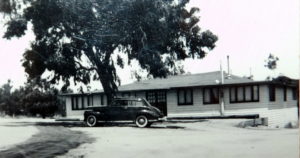
George Gray related life in the 1930s, “It was a place for people who wished to get away from business and city life, at least a part of their time, to the quietness and beauty of a mountain home. It had wonderful viewpoints.”
Music and dancing were great forms of entertainment. Mildred Zimmerman wrote: “Around 1929, dances were held every Saturday night in the Suncrest clubhouse shown above. There was no admission charge, but they passed the hat during the evening and donations were given to the three-piece-band who played for us. When we had square dances, my dad was always the caller for the Virginia Reel. We always enjoyed fox trots and the last dance of the evening was always a waltz. A good time was had by all; the entire family was included.” In December 1932, the entertainment committee of Suncrest, Inc. reported that between June 25, 1932 and December 3, 1932, there had been a total of 26 dances held.
Residents described life on “the hill.” “Dances were held on Saturday nights for the La Cresta-Suncrest people in the clubhouses. The Suncrest Club had 137 members around 1932. Music always played a big part in the lives of the residents. We had to find our own sources of entertainment. In the early 1930s and 1940s, music was provided for the people of ‘the hill’ by Bea LaFrance Eacrett playing the piano and her husband, Dick, on the fiddle. They played for dances at both the Suncrest and La Cresta Clubhouses. A lot of the younger set learned to dance there. The Virginia Reel was a favorite.”
Baseball was a great form of entertainment on “the hill.” The Suncrest Ball Park, located where South Lane Park now stands, had its first recorded game on June 6, 1926 between Savage Tire Company and the Navy team of the USS Sinclair. The games were entertainment for the “resort” members who visited their cabins on weekends. The El Cajon Valley News reported games played between Suncrest and La Cresta at the Suncrest ball diamond. Other games reported in 1939 held at the Suncrest Ball Park included a softball game between two San Diego girl teams, Lakeview Dairy and Jacobson’s Neon Sign. Another account of baseball in 1939 indicated the Suncrest Boys and Girls Club baseball team was beaten by the Dad’s team in a lively “Fathers and Sons” game.
Photo gallery of Life on the Hill in the 30’s


